The hack squat may not be as popular with strength coaches as the barbell squat, but it’s a hidden gem for building lower-body size and strength.
Unlike regular squats, the machine hack squat locks in your form, giving you a quad-focused workout that’s ideal for building mass and boosting athletic performance—all without the joint strain or spinal stress of a barbell squat.
In this expert guide, you’ll learn how to master the hack squat, why it’s so effective, how foot placement influences your results, and more.
What Is A Hack Squat?
The hack squat is a lower-body strength training exercise involving a hack squat machine. Here’s how it looks:
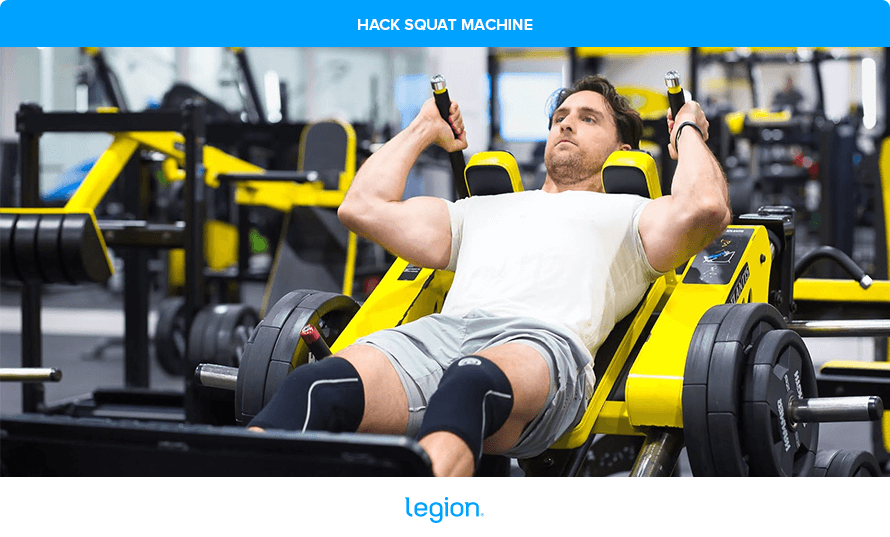
Originally, weightlifters performed the hack squat by placing a loaded barbell behind their heels, squatting down, gripping the barbell, then standing up. In fact, this is how the exercise got its name—”hack” comes from the German word “hacke,” which translates to “heel.”
Nowadays, however, most people prefer the machine hack squat to the barbell hack squat. As such, the machine hack squat is the variation we’ll focus on in this article.
How to Hack Squat
The best way to learn hack squat form is to split the exercise into three parts: set up, descend, and squat.
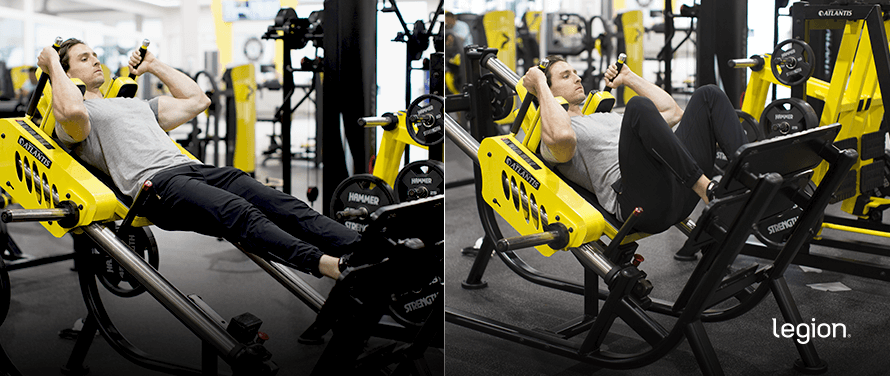

1. Set up
Load the hack squat machine with the desired amount of weight, then position your feet shoulder-width apart on the footplate with your toes pointed slightly outward, your shoulders against the shoulder pads, and your back against the backrest.
Grab the safety handles, then straighten your knees and use the handles to release the weight.
2. Descend
Take a deep breath into your stomach and brace your abs, then while keeping your back pressed against the backrest, lower your body by bending your knees. Allow your knees to move forward in the same direction as your toes.
Lower your body until the angle between your calves and thighs is 90 degrees or slightly less.
3. Squat
Drive your feet into the footplate and straighten your knees to return to the starting position.
Here’s how proper hack squat form should look when you put all of this together:
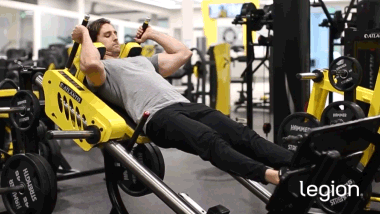

Hack Squat Benefits
Builds Lower Body Muscle
Many gymgoers assume the hack squat is only good for quad growth, but it’s actually an all-around lower-body builder. While it’s an excellent quad exercise, the hack squat also targets your glutes, hamstrings, and calves, and even trains your core and lower back to a lesser degree.
Gentle on Your Joints
Studies show that the hack squat places less stress on your spine and knees than other squat variations, making it ideal for those managing back or knee issues. So, if free-weight squats feel uncomfortable, the hack squat is often a more joint-friendly option.
Enhances Athletic Performance.
Research shows that the hack squat develops lower-body strength, power, speed, and agility, so it’s an excellent exercise for athletes who need to jump, sprint, or change direction at speed.
A common belief among gymgoers is that adjusting your foot placement on the hack squat machine dramatically shifts which muscles you work. While there’s some truth to this, it’s likely overstated.
Currently, there’s no research specifically on hack squat feet position and its effect on muscle growth.
However, studies on similar exercises, like the leg press and barbell squat, offer some clues. These studies suggest that placing your feet higher on the footplate increases glute and hamstring activation, while a lower foot placement emphasizes the quads.
That said, the difference in activation is slight. And since more muscle activation doesn’t always mean more muscle growth, it isn’t clear how much changing the height of your hack squat foot placement affects your long-term results.
When it comes to stance width and foot orientation, research is also mixed.
Most studies show that muscle activation remains similar regardless of how wide your stance is or how you point your toes, though some squat studies suggest that a wider stance emphasizes the glutes and hamstrings, while a narrower stance targets the quads more.
Again, though, the differences are negligible and probably won’t greatly affect your long-term muscle gains.
With this in mind, the most stable, effective, and comfortable hack squat foot placement for most people is one that places your feet halfway up the footplate, a little wider than shoulder-width apart, and with your toes pointing slightly outward.
RELATED: How to Do the Leg Press: Benefits, Form, & Alternatives
Muscles Worked in the Hack Squat
The main muscles worked by the hack squat are:
- Quadriceps (quads)
- Hamstrings
- Glutes
- Calves
It also trains the core and lower back to a lesser extent, too.
Here’s how the main muscles worked by the hack squat look on your body:
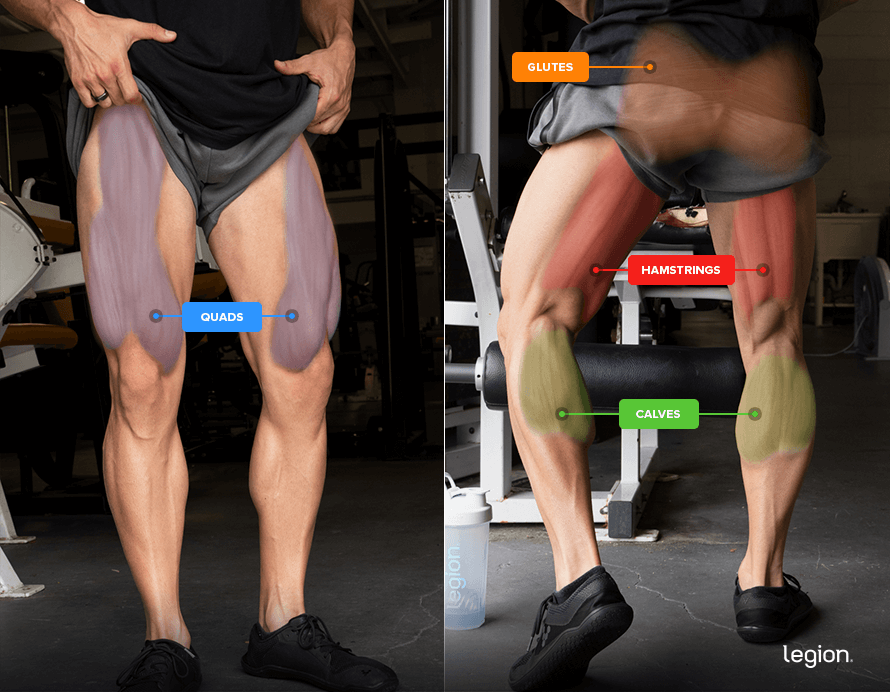

The Best Hack Squat Variations & Alternatives
1. Reverse Hack Squat
The reverse hack squat is similar to the regular hack squat but you perform it facing the machine instead of away from it. This change in position shifts the emphasis to your posterior chain (the muscles on the back of your body), making the reverse hack squat an excellent option for those looking to build their glutes and hamstrings more than their quads.
2. Barbell Hack Squat
The barbell hack squat trains the same muscles as the machine hack squat, so it’s a solid alternative if you don’t have access to a machine. Bear in mind, however, that using a barbell is more taxing on your lower back, grip, and core and requires more balance and coordination, so you generally have to start with light weights and gain strength more gradually.
3. Landmine Hack Squat
The landmine hack squat is a hack squat variation that uses a landmine attachment and barbell in place of a hack squat machine. Like the machine version, the landmine hack squat works all of your lower-body muscles, making it a viable option if you don’t have access to a machine or want to switch up your routine.
4. Smith Machine Hack Squat
If your gym doesn’t have a hack squat machine, the Smith machine hack squat is a reliable alternative. The Smith machine provides stability and control similar to the regular hack squat, allowing you to train the same muscles effectively.
5. Front Squat
While not strictly a hack squat variation, the front squat is a valuable free-weight alternative that targets all of the same lower-body muscles. It’s a great substitute for those who prefer using free weights and want to build leg strength.
FAQ #1: Hack Squat vs. Leg Press: Which Is Better?
Comparing the hack squat vs. leg press doesn’t do either justice—both exercises offer unique benefits depending on your goals.
The hack squat trains your quads through a greater range of motion, making it slightly more effective for quad development than the leg press. However, the leg press is less taxing on your lower back and generally causes less fatigue, making it a good option for those with lower-back issues or for finishing a leg workout when you’re already tired.
Of course, there’s no need to choose only one—the best approach for most people is to include both the hack squat and leg press in their program. For instance, you might do the hack squat for 8-to-10 weeks, take a deload, and then switch to the leg press for the next 8-to-10 weeks.
This alternating approach is how I like to organize my training because it’s a simple way to enjoy the unique benefits of each exercise. It’s also the method I outline in my books, Bigger Leaner Stronger and Thinner Leaner Stronger.
FAQ #2: Hack Squat vs. Squat: Which Is Better?
Thinking of the hack squat vs. squat as an either-or choice misses the full picture—both exercises bring valuable benefits depending on what you want to achieve.
Both the hack squat and back squat effectively train all your leg muscles. The difference is that the back squat trains more muscles throughout your body, and is thus better for gaining whole-body strength.
The hack squat, on the other hand, requires less mobility, balance, skill, and coordination and places less stress on your spine and joints, making it more suitable for beginners, those with limited flexibility, or people working around injuries.
Since it’s generally less taxing, the hack squat is also a good choice for doing extra leg volume (sets) near the end of a workout if you’re already fatigued.
RELATED: How to Do the Back Squat: Form, Benefits, and More
FAQ #3: Can you do a hack squat without a machine?
Yes. The best alternative to the hack squat that doesn’t require a hack squat machine is the barbell hack squat. To perform the barbell hack squat, place a loaded barbell on the floor behind your legs, squat down and grip the barbell, then stand up.
FAQ #4: Where can I learn how to use a hack squat machine?
To learn how to use a hack squat machine, follow the instructions above. Or, if you’d prefer more hands-on instruction, speak to a trainer at your gym. They should be able to show you how to use your gym’s hack squat machine and explain how to perform proper hack squat form.
FAQ #5: Pendulum Squat vs. Hack Squat: What’s the Difference?
The pendulum squat is a lower-body exercise that uses the pendulum squat machine. Here’s how it looks:
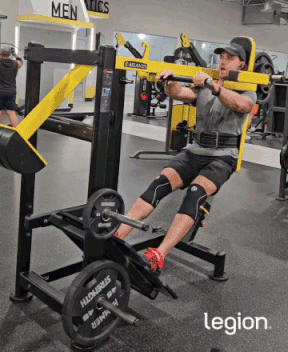

One key difference between the pendulum squat and hack squat is their “resistance curve.” Simply put, each exercise challenges your muscles in slightly different ways throughout the range of motion.
Because of this difference, it doesn’t make sense to compare the pendulum squat vs. hack squat—each offers unique benefits, and incorporating both into your routine is best for developing proportional leg muscle and strength.
RELATED: How to Do Pendulum Squats for Quad Growth
Scientific References +
- Clark DR, Lambert MI, Hunter AM. Trunk muscle activation in the back and hack squat at the same relative loads. Journal of Strength and Conditioning Research. Published online July 2017:1. doi:https://doi.org/10.1519/jsc.0000000000002144
- Erdağ D, Ulaş Yavuz H. Evaluation of Muscle Activities During Different Squat Variations Using Electromyography Signals. ResearchGate. Published January 2020. Accessed June 28, 2023. https://www.researchgate.net/publication/337400852_Evaluation_of_Muscle_Activities_During_Different_Squat_Variations_Using_Electromyography_Signals
- Schwarz NA, Harper SP, Waldhelm A, McKinley-Barnard SK, Holden SL, Kovaleski JE. A Comparison of Machine versus Free-Weight Squats for the Enhancement of Lower-Body Power, Speed, and Change-of-Direction Ability during an Initial Training Phase of Recreationally-Active Women. Sports. 2019;7(10):215. doi:https://doi.org/10.3390/sports7100215
- BLAZEVICH AJ, GILL ND, BRONKS R, NEWTON RU. Training-Specific Muscle Architecture Adaptation after 5-wk Training in Athletes. Medicine & Science in Sports & Exercise. 2003;35(12):2013-2022. doi:https://doi.org/10.1249/01.mss.0000099092.83611.20
- Da Silva EM, Brentano MA, Cadore EL, De Almeida APV, Kruel LFM. Analysis of Muscle Activation During Different Leg Press Exercises at Submaximum Effort Levels. Journal of Strength and Conditioning Research. 2008;22(4):1059-1065. doi:https://doi.org/10.1519/jsc.0b013e3181739445
- ESCAMILLA RF, FLEISIG GS, ZHENG N, et al. Effects of technique variations on knee biomechanics during the squat and leg press. Medicine & Science in Sports & Exercise. 2001;33(9):1552-1566. doi:https://doi.org/10.1097/00005768-200109000-00020
- Vigotsky AD, Beardsley C, Contreras B, Steele J, Ogborn D, Phillips SM. Greater Electromyographic Responses Do Not Imply Greater Motor Unit Recruitment and “Hypertrophic Potential” Cannot Be Inferred. Journal of Strength and Conditioning Research. 2017;31(1):e1-e4. doi:https://doi.org/10.1519/jsc.0000000000001249
- Murray N, Cipriani D, O’Rand D, Reed-Jones R. Effects of Foot Position during Squatting on the Quadriceps Femoris: An Electromyographic Study. International journal of exercise science. 2013;6(2):114-125. https://www.ncbi.nlm.nih.gov/pmc/articles/PMC4882472/
- Martín-Fuentes I, Oliva-Lozano JM, Muyor JM. Influence of Feet Position and Execution Velocity on Muscle Activation and Kinematic Parameters During the Inclined Leg Press Exercise. Sports Health: A Multidisciplinary Approach. Published online June 4, 2021:194173812110163. doi:https://doi.org/10.1177/19417381211016357
- Martín-Fuentes I, Oliva-Lozano JM, Muyor JM. Muscle Activation and Kinematic Analysis during the Inclined Leg Press Exercise in Young Females. International Journal of Environmental Research and Public Health. 2020;17(22):8698. doi:https://doi.org/10.3390/ijerph17228698
- Sinclair, Jonathan, et al. “A Multi-Experiment Investigation of the Effects Stance Width on the Biomechanics of the Barbell Squat.” Sports, vol. 10, no. 9, 14 Sept. 2022, p. 136, https://doi.org/10.3390/sports10090136. Accessed 7 Oct. 2022.
- Paoli, Antonio, et al. “The Effect of Stance Width on the Electromyographical Activity of Eight Superficial Thigh Muscles during Back Squat with Different Bar Loads.” Journal of Strength and Conditioning Research, vol. 23, no. 1, Jan. 2009, pp. 246–250, https://doi.org/10.1519/jsc.0b013e3181876811.
- Larsen, Stian , et al. Effects of Stance Width and Barbell Placement on Kinematics, Kinetics, and Myoelectric Activity in Back Squats. 31 Aug. 2021, https://doi.org/10.3389/fspor.2021.719013.
- Delmore, Robert J., et al. “Adductor Longus Activation during Common Hip Exercises.” Journal of Sport Rehabilitation, vol. 23, no. 2, May 2014, pp. 79–87, https://doi.org/10.1123/jsr.2012-0046.
- Schoenfeld, Brad J, and Jozo Grgic. “Effects of Range of Motion on Muscle Development during Resistance Training Interventions: A Systematic Review.” SAGE Open Medicine, vol. 8, no. 8, Jan. 2020, p. 205031212090155, https://doi.org/10.1177/2050312120901559.
- Kubo K, Ikebukuro T, Yata H. Effects of squat training with different depths on lower limb muscle volumes. European Journal of Applied Physiology. Published online June 22, 2019. doi:https://doi.org/10.1007/s00421-019-04181-y

